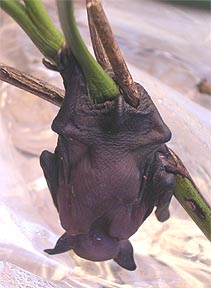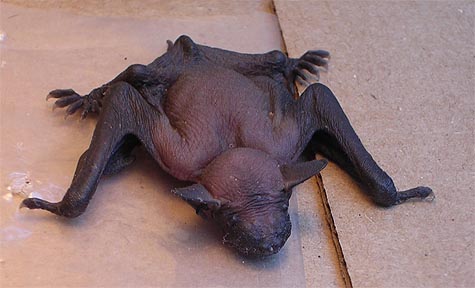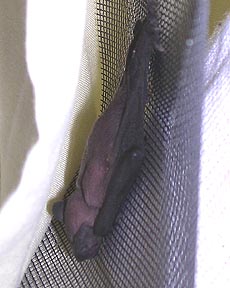I've learned a lot more about caring for baby bats since I first posted this in 2005.
Please visit Baby Bats, Spring 2012 for more accurate information.
While trimming some bushes along the side of my house on the morning of June 23, 2005, I saw something that I first thought was a dead leaf on a branch. Upon closer inspection, I realized that it was a baby big brown bat. Each spring a colony of pregnant bats roosts in the louvers of our attic on the west side of the house (totally ignoring the bat house I installed at the edge of my yard...sigh), and every year an unfortunate baby or two falls out of the louvers.

I thought it was dead and so I started to put the branch (with inverted bat still attached) in my garden cart--but then it moved!
The baby was so young that it was still hairless, and it was so weak that it wasn't even "peeping." (A baby bat that's separated from its mother will usually peep almost constantly.) Even if its mother was still alive--unfortunately, many big brown bats are eaten by owls--it was very early in the day and I didn't think the baby would survive unattended until nighttime. So what to do?
I called Robin Eastham, a local bat and wildlife rehabilitator in Virginia. Specially licensed bat rehabilitators like Robin are trained to care for lost or injured bats, and she said that I should keep it warm and try to get it to drink some Pedialyte until I was able to bring it to her. (I had a repairman coming to fix my dryer so I couldn't leave right away....)
I quickly rigged up a makeshift "incubator" on my front porch. I put a ziplock bag filled with warm water in a small basket inside a box, and then I positioned a clamp lamp over the box to provide additional warmth. (I've since learned that it would have been much better to have heated uncooked rice in an old sock instead of the using the water-filled plastic bags and clamp lamp. The soft sock would have provided warmth and comfort, without the added stress of the bright light over the box.)

But once the box was ready, branch and bat were transferred to the impromptu "nursery" and I went to the store for the Pedialyte. After warming the unflavored liquid, I offered it to the bat with a small, clean, soft paintbrush. To my surprise, it lapped at the Pedialyte and it began peeping and moving around. Amazing! (I wonder how many people can say they've seen a baby bat's tongue?)
Brown bats are "crevice dwellers" and therefore they aren't really designed to hang from branches. This poor baby simply couldn't get comfortable, which was a problem, given that it became more active after taking the liquid.




It finally got situated and took a brief (inverted) nap while the appliance repairman was here.

And no doubt the repairman had quite a story to tell when he got back to his shop...sigh....
I got the bat to drink a little bit more of the Pedialyte, but then it wiggled and crawled its way out of the small basket and onto the bottom of the box.

Since I was ready to take it to Robin then anyhow, I removed the basket and branch, closed the box and put it in the car. It was very strange to hear light scratchings coming from the box while I was driving--especially since I knew what was IN the box! It's not every day that I find myself transporting a baby big brown bat in a box....
I left the baby at Robin's barn, along with my phone number and address. When she called a short time later, she said that the bat--a baby girl--was doing surprisingly well and that the Pedialyte had probably saved her life, warding off dehydration.
As with most young mammals, however, they are far better off being raised by their mothers than by other caregivers, and so the decision was made to return the baby to my house in hopes that the mother would retrieve it. We started just before dark and made a special platform below the louvers. The bat was placed in the folds of a pillow case which had a piece of nylon screen sewn in the center. A bag filled with warm, uncooked rice was placed behind the baby to keep it from getting chilled.



A little before 10 p.m. Robin returned to check on the baby bat. Unfortunately she was still in the pillow case and the rice bag had cooled down. I heated the rice again and Robin gave her more of the Pedialyte, which she eagerly lapped up. After the baby had eaten her fill, Robin returned her to the pillow case.
I checked on her again at 12:30 a.m. and she was still unclaimed. The temperature was in the mid-60s, the rice bag had cooled, and so (wearing gloves that Robin had given me) I gently removed her from the screen she was clinging to, gave her more Pedialyte, and placed her into the carrier that she'd been brought back in. (I first reheated the rice bag so that the carrier was nice and warm.) She spent the night in my house, shut in a dark bathroom.
By morning she was alert and very hungry--and her tiny eyes were open for the first time! She eagerly lapped at the Pedialyte, actually latching onto the paintbrush and sucking on it, but it clearly wasn't what she wanted or needed. After hydrating her, I re-warmed the rice bag, put her back in the carrier and headed back to her foster mom's farm, where she received a baby bat-appropriate breakfast.
As it appears that this baby is orphaned, she'll be hand-raised by Robin until she's able to fend for herself. She'll probably be released here, with hopes that she can rejoin her colony and ultimately find her way to the area where they hibernate each winter.

As I say on each of the "bat pages" on my website, I was caring for this baby Big Brown bat with the support of a licensed wildlife rehabilitator. As a safety-conscious rescuer and temporary caregiver, I can help keep a young or injured wild animal warm and hydrated, but turning it over to a wildlife specialist gives it the best possible chance of surviving and someday returning to its natural habitat, where it belongs.
There is so much misinformation, superstition and fear about bats. One long-standing myth is that "all bats" are rabid. Not true! Less than one-half of one percent of bats contract rabies, but that said, it is important to remember that any frightened or injured wild animal can bite! For that reason, no bat should be handled with bare hands. Wildlife rehabilitators who plan to work with rabies vector species must receive a series of pre-exposure rabies vaccinations before they can be licensed.
I think that our cultural view of bats has been largely shaped by frightening images of "Dracula" and Halloween, and by what little most people know about real vampire bats. By contrast, in China bats are seen as symbols of happiness, longevity and good luck!
The unfortunate bat in a house--scared witless and usually being chased by a frantic human armed with a tennis racket or broom--is certainly going to look and sound as fierce as it possibly can. Additionally, most pictures of bats show them in a defensive posture, and that has only served to perpetuate the very negative and scary image that people have of them.
Bats are mammals, meaning that the babies are born alive and suckle milk from their mothers. On average, female bats give birth to just one baby per year, and they can live for 20 years! They are more closely related to primates than they are to rodents, and they are not blind. Many species of bats are in danger of extinction due to White Nose Syndrome, loss of habitat, and accidental or intentional eradication and extermination due to human fear and ignorance.
For more information about these highly intelligent, vitally important and gentle creatures, please follow the links below.
Bat World Sanctuary and Educational Center
Bat World Sanctuary on Facebook
Bat Conservation International, Inc.
Bat Rescue Resources by State
What is Killing the Bats? (Smithsonian Magazine, August 2011)
The Bat Lady (ConnectKids website, 2007)
Bat-Related Articles on my Website
Baby Bats, Spring 2012
Baby Bats, Spring 2011
Big Brown Bat, Winter 2011
Baby Bat, 2010
Baby Bat, 2005
Other Resources
Highly recommended for those interested in the science behind animal behavior: